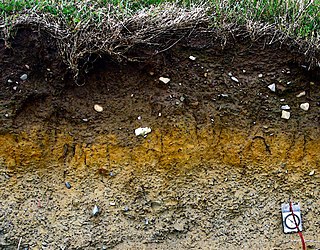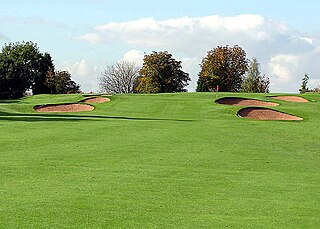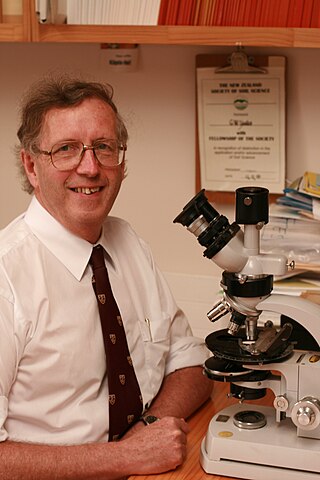
Soil, also commonly referred to as earth or dirt, is a mixture of organic matter, minerals, gases, liquids, and organisms that together support life. Some scientific definitions distinguish dirt from soil by restricting the former term specifically to displaced soil.
Soil formation, also known as pedogenesis, is the process of soil genesis as regulated by the effects of place, environment, and history. Biogeochemical processes act to both create and destroy order (anisotropy) within soils. These alterations lead to the development of layers, termed soil horizon, distinguished by differences in color, structure, texture, and chemistry. These features occur in patterns of soil type distribution, forming in response to differences in soil forming factors.

In agriculture, cover crops are plants that are planted to cover the soil rather than for the purpose of being harvested. Cover crops manage soil erosion, soil fertility, soil quality, water, weeds, pests, diseases, biodiversity and wildlife in an agroecosystem—an ecological system managed and shaped by humans. Cover crops may be an off-season crop planted after harvesting the cash crop. Cover crops are nurse crops in that they increase the survival of the main crop being harvested, and are often grown over winter. In the United States, cover cropping may cost as much as $35 per acre.

Nutrient management is the science and practice directed to link soil, crop, weather, and hydrologic factors with cultural, irrigation, and soil and water conservation practices to achieve optimal nutrient use efficiency, crop yields, crop quality, and economic returns, while reducing off-site transport of nutrients (fertilizer) that may impact the environment. It involves matching a specific field soil, climate, and crop management conditions to rate, source, timing, and place of nutrient application.
Soil acidification is the buildup of hydrogen cations, which reduces the soil pH. Chemically, this happens when a proton donor gets added to the soil. The donor can be an acid, such as nitric acid, sulfuric acid, or carbonic acid. It can also be a compound such as aluminium sulfate, which reacts in the soil to release protons. Acidification also occurs when base cations such as calcium, magnesium, potassium and sodium are leached from the soil.

In agriculture, leaching is the loss of water-soluble plant nutrients from the soil, due to rain and irrigation. Soil structure, crop planting, type and application rates of fertilizers, and other factors are taken into account to avoid excessive nutrient loss. Leaching may also refer to the practice of applying a small amount of excess irrigation where the water has a high salt content to avoid salts from building up in the soil. Where this is practiced, drainage must also usually be employed, to carry away the excess water.

Golf course turf is the grass covering golf courses, which is used as a playing surface in the sport of golf. The grass is carefully maintained by a greenskeeper to control weeds, insects and to introduce nutrients such as nitrogen fertilization. The grass is kept at a constant height by mowing.
Ruth Mason was a New Zealand botanist specialising in the taxonomy and ecology of freshwater plants. She was employed at the Department of Scientific and Industrial Research for 35 years undertaking research into aquatic plants, pioneering new techniques for plant preservation and collecting over 13,000 plant specimens in the field. She was awarded life membership by the New Zealand Ecological Society.

Gregor William Yeates, publishing as GW Yeates, was a New Zealand soil zoologist and ecologist. He was "considered the world's leading authority in soil nematode ecology, a subject of economic and ecological importance."
The increase in pollution of the Mississippi River has greatly affected the species that live in the water, as well as those who rely on the river for food and recreational purposes. One of the main types of pollution is an excess of nitrate caused by chemical wastes from power plants and agricultural runoffs. The watershed covers about 40% of the lower 48 states, with 7 of the 10 top agricultural producing states being within this watershed.
Morice Fieldes was a New Zealand soil chemist and science administrator. He worked initially at Chemistry Division, DSIR, before moving to Soil Bureau, where he rose to be director. The New Zealand Society of Soil Science has an award in his memory.
The soil matrix is the solid phase of soils, and comprise the solid particles that make up soils. Soil particles can be classified by their chemical composition (mineralogy) as well as their size. The particle size distribution of a soil, its texture, determines many of the properties of that soil, in particular hydraulic conductivity and water potential, but the mineralogy of those particles can strongly modify those properties. The mineralogy of the finest soil particles, clay, is especially important.

Donald L. Sparks is an American soil scientist, currently Unidel S. Hallock duPont Chair of Soil and Environmental Chemistry, Francis Alison Professor, and Director, Delaware Environmental Institute, University of Delaware.
Philippa Marion Wiggins was a New Zealand academic, who made significant contributions to the understanding of the structure of water in living cells.
Marion Frances Robinson was a New Zealand nutritionist and physiologist. She was professor of nutrition at the University of Otago, and is particularly noted for her investigation of the importance of selenium in the human diet.

Octolasion lacteum is a species of earthworm of the genus Octolasion. In New Zealand it has been found in West Coast soils and in Canterbury. They are found in mostly moist areas deep under the soil as they feed in the nutrients within the soil. Unlike other worm species, these are known to survive in acidic soil as well as soil that is not as organic compared to other places. They provide some important roles in the ecosystem as well as threats to other species as well. After a drought, they help the soil get more organic by adding more carbon dioxide in the soil and the waste from the O. lacteum also provides nutrients for the soil. In another case, they can also be invasive in a way that they suck up carbon in the soil which means plants have less causing a disruption to the food web. Lastly, they reproduce by cross parthogenic reproduction.
Dianne Sika–Paotonu is a New Zealand immunologist, biomedical scientist and academic in the Department of Pathology and Molecular Medicine and Associate Dean (Pacific) at the University of Otago Wellington. She is of Tongan descent and is the first Pasifika biomedical scientist to receive the Cranwell Medal for science communication.

Alison Stewart is a Scottish-born New Zealand biologist who specialises in plant pathology. As of 2022 she is the CEO of the Foundation for Arable Research, based in Christchurch.
Serita D. Frey is an American academic and ecologist, who serves as Professor of Environmental Science at the University of New Hampshire. Her research considers how human activities impact terrestrial ecosystems.
Beverley Rae Clarkson is a New Zealand botanist, ecologist and wetland researcher and conservationist. She is best known for her research into and her conservation work with New Zealand wetlands. In 2021, the city of Hamilton awarded her the Hamilton-Kirikiroa Medal. In the same year Clarkson was awarded the New Zealand conservation award, the Loder Cup.









